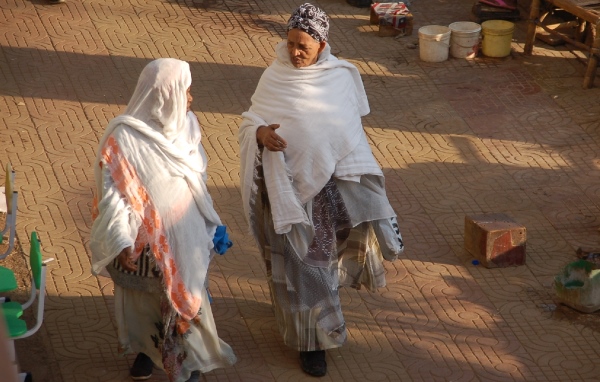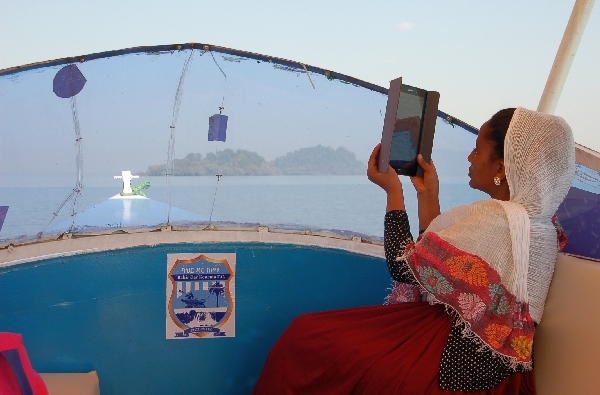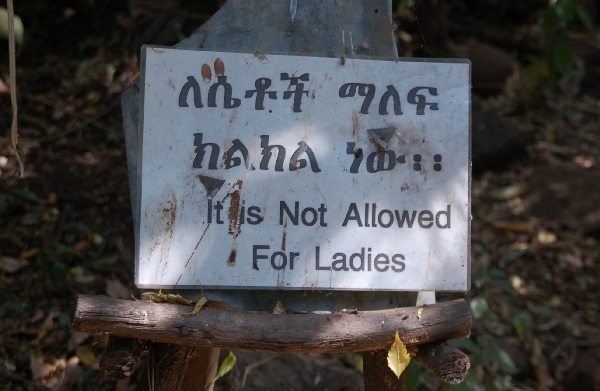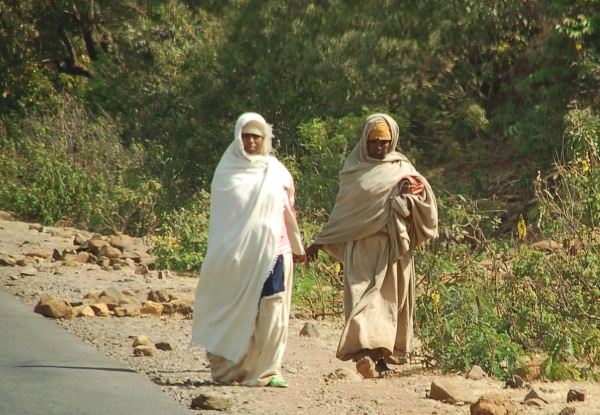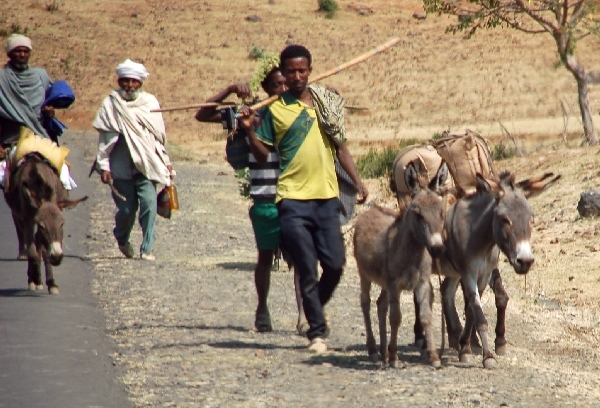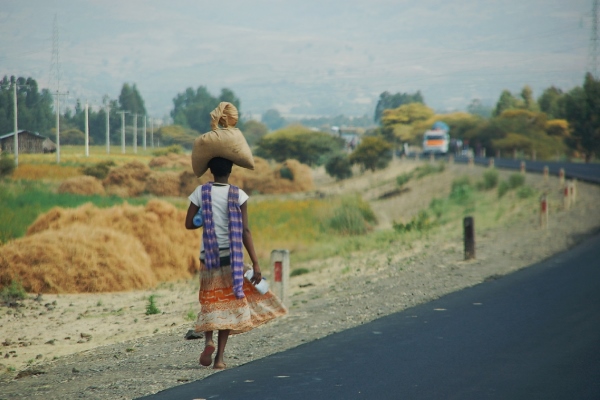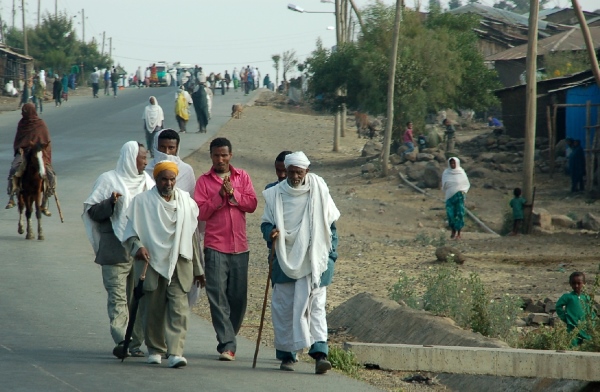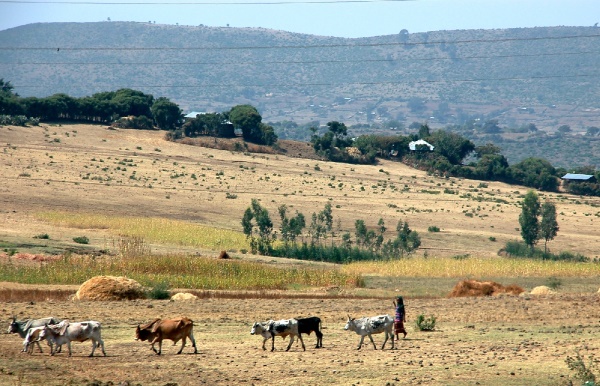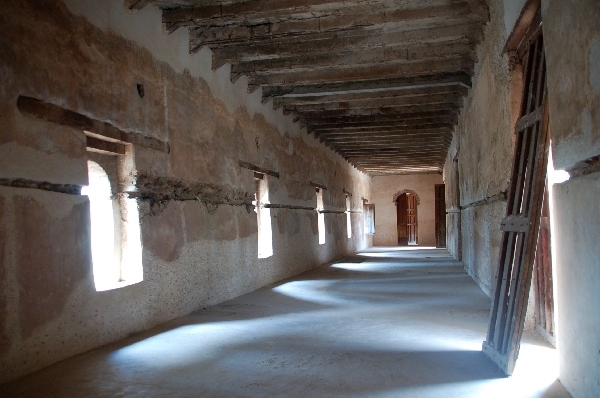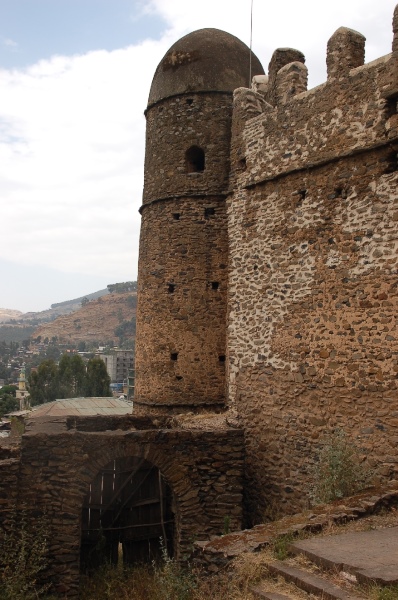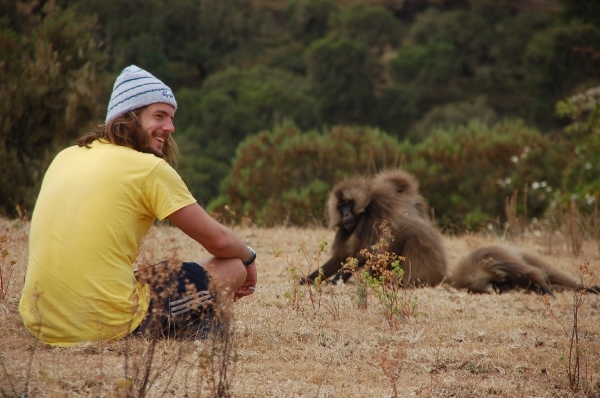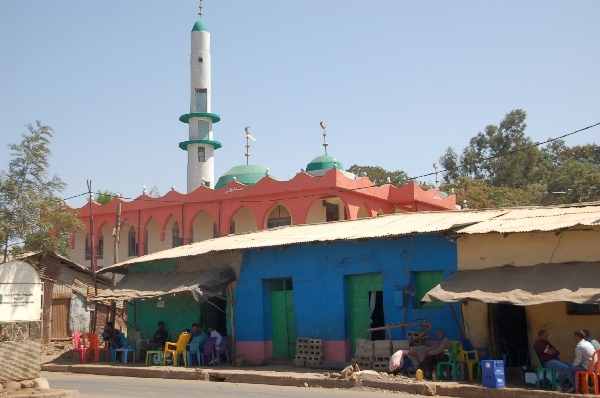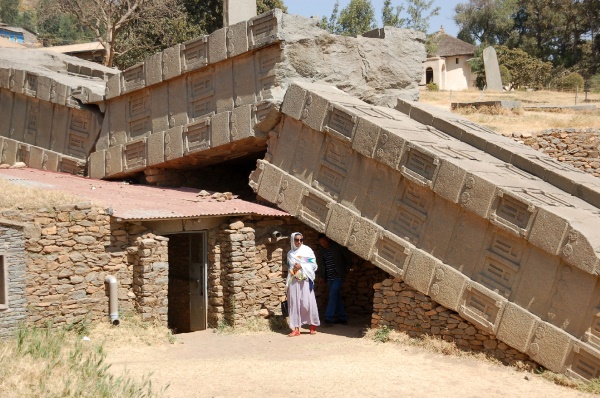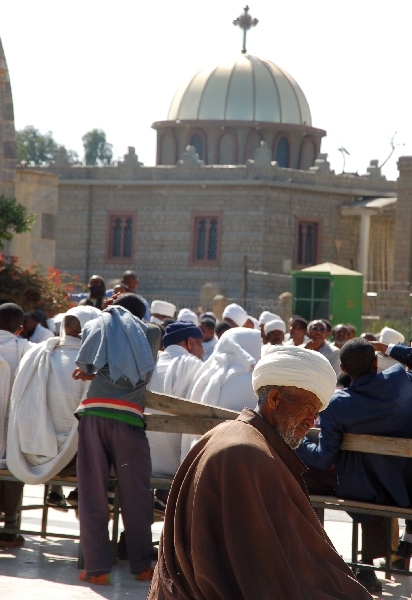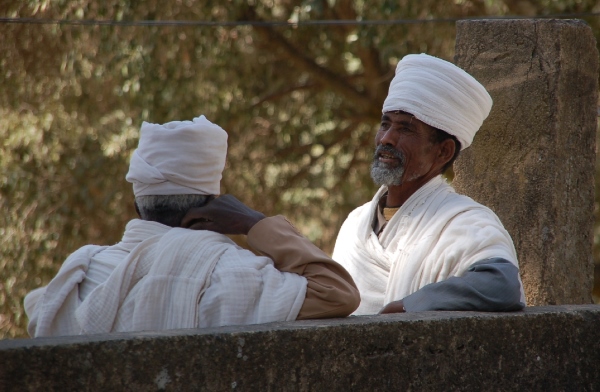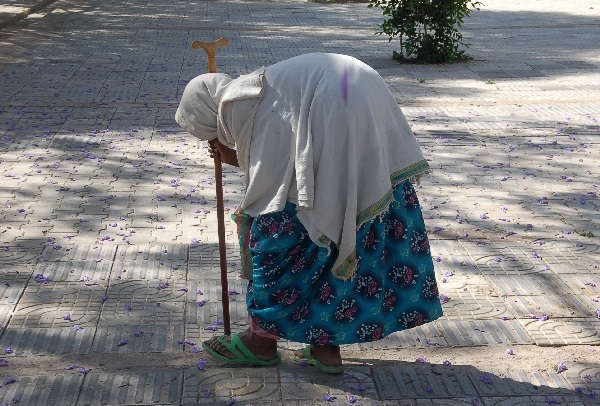World traveler Clown Tom Bolton
Adventure stories & photos

Toms adventure travels to Ethiopia, Africa
For those who don’t know anything about Ethiopia, it is in northeastern Africa. It’s about twice the size of Germany. Most of where I visited was not overly hot although it’s not far from the Equator because it is very mountainous. Most of the places I was in were between 2000 and 3000 meters altitude. It was mostly dry and dusty but I was also there at the driest time of the year. It gets repeated ad nausea that Ethiopia was the only country in Africa not to be colonialized – although it was occupied by Italian forces under Mussolini. Some of the oldest humanoid remains and archeological finds have been unearthed in Ethiopia’s Afar region.
Maybe it’s befitting that a place where people have been around so long have their own way of telling time. They use a calendar based on what was used by the ancient Egyptians although they added some corrections like done by the later Julian calendar. The widely accepted Julian calendar was replaced in most of the world by the Gregorian calendar starting in 1582. Unique to all of them, the Ethiopian one has 12 months of 30 days plus a 13th month of 5 or 6 days. And there clocks are 6 hour difference than the international standard. For them, the day starts at what we call 6 am rather than midnight. Their 6 o’clock is our noon. Airlines for example will use international times – so one always needs to confirm a time schedule if it is local time or international time.
Ethiopia is a landlocked country where coffee is said to have originated. Most of the 100+ million inhabitants live from agriculture and herding. The main food staple injera is similar to a large crepe and is made from an endemic grain called teff . Religious mores influence much of Ethiopian society. The majority of people follow the Ethiopian Orthodox Tewahedo Christian tradition but there is also a large minority of Muslims. Most Ethiopian Jews migrated to Israel in the 1970’s but they had a long history and even their own empire in the region.
Capital city Addis Ababa, Ethiopia
I went to Ethiopia, Africa from mid-Jan. to mid-Feb. 2018. My adventures took me from the capital city of Addis Ababa to Bahir Dar. From there I visited monasteries during a boat tour of Lake Tana and a visit to the Blue Nile Waterfalls. Then on to the city of Gondar with its old fortress. Trekking in the Simian Mountains was followed by seeing ruins and the church with the Ark of the Covenant in the historical city of Axum. The additional page Ethiopia-2 continues my travel on to Merkele and Wukro and a stone carved church in Tigray. Then the famous stone hewed churches and sites of Lalibele. The market there and the one in Bati were visual wonders. The most charming at last was the old city of Harar in eastern Ethiopia. This travel was a challenge as I had expected but civil unrest also limited my movements towards the end. Yet I got to most of the places I had intended and made my flight home without any bodily harm so it all ended well.
Upon arrival in Addis, I went to the area known as Piazza or Piassa – seems every word there has alternative spellings. This area a bit north of the center has most of the cheap accommodation plus plenty of shops, restaurants banks etc. I stayed at the Itegue Taitu Hotel which was a former palace and actually the first hotel in Ethiopia. Despite its historical significance it is relatively cheap. The reason being that it is very run down. When I returned to Addis later on my journey I chose to stay at another nearby place the Baro Hotel that had rooms that cost a bit more but were much nicer.
Piazza & St. George’s Cathedral
Above the area known as Piazza is the St. George Cathedral. This became my first introduction to The Ethiopian Orthodox Church which has had a profound influence on the region since the fifth century AD. I happened to arrive at the beginning of Timkat, as the local celebration of the Epiphany is called. The Cathedral was surrounded by church goers dressed up in their best cloths. The high point of the celebrations are when copies of the Ark of the Covenant are paraded through the streets while people strew grass along the route. A corner stone of Ethiopian religious mythology is that the original Ark of the Covenant is stored in a church in Axum in northern Ethiopia.
Just below the Cathedral is a traffic circle with a statue. About 10 minutes stroll from there I encountered one of the large mosques that also dot the city. Although there were also later conflicts between the Ethiopian Orthodox regimes and Islamic ones, Islam is a large minority in the country. It is said that the prophets’ early followers were welcomed and allowed to practice their beliefs and for most of its history, the religions have peacefully co-existed in Ethiopia. Something else to note in the last picture is the wooden scaffolding at the mosque and building in the background. Even the highest, most modern buildings seemed to use the same construction method. Unsawed logs were bound together with a single nail at each junction. I don’t know if they ever put any serious weight on these scaffoldings but they looked rather risky in any case.
Sites of Addis Ababa, Ethiopia
There are not really a lot of spectacular sites in Addis Ababa. But in a nearby part of town is the National Museum of Ethiopia. I took a minibus to get to the area which is a shared van that suplements the local buses. From where I got out I still had to walk half a kilometer and passed another large church on the way. I also passed a number of street people. One didn’t see people starving in the streets but there is still plenty of poverty.
The National Museum, Ethiopia
The National Museum of Ethiopia was fairly well presented and only cost 10 Birr entrance – about 35 American cents. This turned out to be one of the better deals in all of Ethiopia since even the smallest church or site would charge 100 to 200 Birr – or more. There were English explanations for some things but not for every artifact. The highlight of the museum is “Lucy” and a number of other important remains of human ancestor. These were displayed in the basement and the only reason I can think of that I took no pictures is that they were not allowed in that section. It seemed a paradox that such significant artifacts were so humbly presented. One also questions the conclusions about man’s development that have been inferred from such incomplete collections of bone fragments. In addition to humanoid remains there is a wide variety of art, cloths, carvings, baskets, coins, weapons, and tools. The history of many regimes and empires that were present in the region are covered in detail.
Ethnological Museum aka Institute of Ethiopian Studies
About 10 minutes walk from the National Museum is the Ethnological Museum which is housed in an Art Deco styled building on the main University campus. To enter the campus I had to show my passport and get a quick frisking for weapons. The museum itself had a lot of detailed explanations in English which was an exception. They also had a good selection of artifacts. In all, I would give it an even higher rating than the National Museum. Likely it is the best museum in Ethiopia.
Water bottles ruining environment in Ethiopia
This was a typical small kiosk, no different in Addis Ababa than elsewhere in Ethiopia. What was good was that safe drinking water was readily avaiable most everywhere. The problem is that it and other drinks are sold in disposable bottles that get thrown in the street. Along with plastic bags, this has become a ridge of plastic garbage that lines every meter of roadside throughout the country. Glass bottles have a deposit and are returned to be used again. Hopefully, Ethiopia will consider a strategy like in Germany that puts a high deposit on most plastic bottles as well. Afterwards they are recycled rather than reused. People will collect any deposit bottles thrown away so this results in nearly 100% compliance.
Bus trip to Bahir Dar – typical Ethiopian landscapes
After 4 nights in Addis Ababa I was ready to go north to see historical sites. I booked a luxury bus to Bahir Dar on Sky, one of the most recommended companies in Ethiopia. The night before I should leave, I was told at my hotel that the bus was cancelled but they had booked me on another company Abay – also leaving at 5 the next morning. According to the ticket the price was a bit less but as long as I could get there I was not worried about trying to get a refund. The problem was that most such long trip bus trips leave at ungodly times. I had been assured by the hotel management that the taxi to get to the bus was 150 Birr at that time but then the taxi driver demanded 250 saying it was the “night time” price.
I managed to argue the guy down but he seemed pretty sour and demanded that I give an apology in light of his generosity. I guess one needs to be thankful when they are not taken advantage of and only pay the going tourist rate. I took a lot of photos from the window but naturally they are not very sharp. But I am including these as typical scenes I saw on this 500+ kilometer trip. Typical of all of central and northern Ethiopia were rolling hills and mountains dotted by small farms, grass and a lot of grazing animals. One saw haystacks everywhere and at one point there must have been a good 50+ kilometers of endless ones. On the land and along the roadsides were many people, including kids herding goats and cattle – or carrying heavy loads of wood or hay.
Arriving in Bahir Dar, Ethiopia
I arrived in Bahir Dar but it took me a while to realize that I was on the other side of the center than where I expected to land. What I was to learn is that there are often multiple bus stations in Ethiopian cities, some of which are kilometers out of a town center. And the luxury buses tended to all have their own spot to drop people off. Eventually I found my orientation by getting near the shore of Lake Tana. The central point of interest being the inevitable St. George church shown below.
I stayed in a very cheap hotel nearby that was said to be a backpacker hangout. In hindsight I should have spent a bit more for a better place as it turned out to have a lot of mosquitos. Yet I seemed to be one of the only westerners there. Another close by place had a better recommendation but was full. And even there were only a handful of non-Ethiopians. I was wondering where all of the foreign travelers were. The answer is that there simply aren’t many in Ethiopia! The biggest advantage of this hotel was the café that provided a good view-point overlooking the main street.
Lake Tana, Blue Nile River
The main feature of Bahir Dar is Lake Tana. It’s rather shallow but the largest lake in the region and infamous for being the source of the Blue Nile River. There is some nice parkway along the lake and an area with souvenir shops and cafes right by the lake. There was even a restaurant out on this pier but they charged people an entrance fee just to enter so I passed on going there. The hippo sculptures are representative of the hippos that tend not to dwell in the lake itself but in the Blue Nile River which starts just a few kilometers from the center of town. Between the park with the hippos statues there was also an area with many souvenir shops. There was also a Ferris wheel but I never saw it in operation and there weren’t really any families with kids hanging around
.
Looking for hippos in the Blue Nile River
I took a tuk tuk aka a bajaj (3 wheeled motorcycle taxi) to a bridge over the river to look for hippos that hide themselves in the grassy banks during the day. Unfortunately, it was too late in the day since they usually appear early in the day and before sunset. I did see a lot of birds and some very large lizards – managing to take a few photos before getting yelled at by the Ethiopian soldier posted at one end of the bridge.
Monastery boat tour of Lake Tana
Other than being the source of the Blue Nile River, the main feature of interest at Lake Tana is its many small monasteries both on shore and on islands within the lake. I booked a boat tour that included 5 monasteries. Included was the transportation and guide but each of the monasteries had an additional 100 Birr entrance fee. The rest of my group were 3 Ethiopians couples. They all seemed pretty well off, carrying multiple smart-phones and tablets to document their trip. Fortunately, most of them spoke passable English and they went out of their way to help translate information to include me in the group. Unfortunately, our boat was outfitted with a small motor and we wasted a lot of time getting around despite having fairly smooth waters. It was interesting to be along with people who strongly believed in the religion yet it was also a bit disconcerting. At one of the monasteries they were selling brilliantly colored scarves which I joked were probably made in China. It was quickly pointed out to me that they were handmade right there.
Another thing was local mythology. For example; on one of the islands it is said that there is a tunnel built under the lake adjoining it to another nearby island. Yet to dig such a tunnel at least 500 meters long, securely under a lake was obviously a fantasy. It would have taken hundreds of men working for hundreds of years – and for what purpose? As if monks wouldn’t have better things to do with their time like praying or learning scripture. My response was; okay, let’s see it! But of course this was not allowed yet none of my companions could understand that one could doubt the story. If the monks say it’s so – then it must be true. One of the islands was also off limits to women; something I would encounter at other Ethiopian churches. Not that I haven’t experienced this kind of attitude before but it is always strange that I could visit a holy place as a male non-believer but a female local couldn’t. Otherwise I had a strong feeling that while a patrilocal society, Ethiopian women were fairly independent, had a strong attitude and asserted their position rather well.
Monastary architecture
All of the monasteries were rather small, looking more like chapels. The architecture was always similar, round buildings. Inside, an outer ring where a few things were stored but mostly providing another set of doors as barriers to the inner sanctuary. Within there were colorful murals depicting religious scenes. Tapestries were hung in front of doors to a hidden inner most area which one was not allowed to see. The monastery building itself was always inside of a fenced off compound. Just inside the entrance was usually a couple of large stones suspended by wire that made a ringing sound when struck with the accompanying smaller stones. This was not unlike a gong but to what purpose? I assumed there was more ceremonial significance than just being a doorbell.

Ethiopian holy water
At one of the monasteries the monk was handing out cups of boiling water after showing us around. I figured it was just a refreshment although I would have prefered a coffee or tea. I was quickly informed that this was holy water and just for Ethiopian Orthodox believers. They asked me what my religion was and I replied; “I was raised Catholic” to avoid any big discussions although I have deliberately left the church and consider myself free from any religion. In light of this, the monk sprayed water on me and mumbled what I assume was a short prayer. I accepted it as a positive gesture – although Ihad to clean the drops off of my camera lens.
Ethiopian last supper
After visiting one of the monasteries we got taken to an adjoining building where the monks were eating. Fitting was that there was a copy of a painting of the last supper on the wall behind. I was actually hungry but not sure if the food was vegetarian or if we would be charged for it. We had been promised a meal but at the end of the tour which never materialized as we were behind schedule. The other thing was that I really didn’t care much for the local Ethiopian staple injera that they were serving – although I could eat it if necessary. I might have insulted their sense of hospitality but when in doubt I just didn’t eat.
I usually get very light headed when I miss a meal but I never felt overly hungry in Ethiopia. There were some long bus rides where we also stopped at restaurants where nobody spoke English and there was no menu. I looked for bread and bananas or just didn’t eat. I also have a small bladder. Although there were stops to pee in the bushes on long bus trips they could easily be 3, 3 or more hours between. My strategy was to drink sparingly and rehydrate upon arrival.
Blue Nile Waterfalls
The other big attraction from Bahir Dar is to visit the Blue Nile Waterfalls. I booked the monastery lake tour and a waterfall tour from the same agency. The lake tour was 8 – 13 hours. I think we were supposed to go to the junction where the Blue Nile comes out of Lake Tana but we were behind schedule and the small motor was straining as the water had gotten a bit choppy. One back at the cocks there was no opportunity to eat like schedules. I was immediately put into a van and joined by a number of other westerners who seemed to also be coming from various boat tours. But the driver had some problems with the van and we drove a short distance and got changed to another van with another driver. We then had a drive of an hour after leaving the limits of Bahir Dar on an unpaved, dusty road. The dust aggravated my lungs but there were interesting scenes of people in the countryside as shown below. What was clear is that while not all Africans or Ethiopians live in mud huts of course – many still do!
All included tour? Except the guide and ferries…
Once we got to the park entrance for the Blue Nile Waterfalls the chaos began. We were behind schedule and it was suggested we take a ferry across the river in both directions rather than a longer walk that would entail just one ferry towards the end. It was also strongly pushed that we take a guide although it is not actually required. The confusion was about who had paid for what? We had all paid different prices based on different promises. My tour was supposed to include entrance, transport and a guide but the driver claimed he was only informed of 2 others having paid for the entrance but he gave in when I insisted. The ferry rides would later cost an extra 20 Birr per person per ride. I paid without argument but was not sure at the time if it shouldn’t have been included under “all transportation”. I also chipped in 50 Birr for the guide in the end just to see that things got done rather than wasting time discussing the situation. My feeling was that most such conflicts in Ethiopia were misunderstandings rather than bad intentions.
From the park entrance we drove a couple of more kilometers, parked and had a short walk to the ferry which was mostly used for transporting locals and their goods – like this load of sugarcane. We then had a kilometer or two past fields including the local drug chat that is chewed like coca leaves are in the Andes. Near the first views of the waterfalls was a woman hand spinning cotton thread. It was something I was to see elsewhere in the country but that she was doing it at that particular place was obviously to pose for photos and demand a fee. A handful of local kids also dogged our every step insistently offering us souvenirs.
The falls themselves are not overly spectacular since it was the dry season and I’ve read that much of the water is still being diverted due to a dam. But the mist and the foliage at and just below the falls was magical. From there the river has created a gorge that one can cross on a very high suspension bridge. The amount of water going over the dam was not such a factor to me but they say the micro-environment there is being highly impacted. Also, the countries down river are not so happy about Ethiopia’s dam projects. This is the kind of thing that can lead to wars.
Road trip to Gondar, Ethiopia
From Bahir Dar my next destination was further north to Gondar. The name always makes me think of something out of a Tolkien novel and the images only re-enforce the feeling. To check on transportation I went to the public bus station. Such buses ae not the same standard as the luxury ones but reasonably dependable. Unlike in many third world countries the rules in Ethiopia, which are actually enforced for the most part, require that everyone have a seat. Of course they fill up with lots of baggage inside and on the roof, including crowing chickens and goats on occasion but nobody is forced to stand.
In the end my first experience on such Ethiopian buses was delayed as I had met a guy who said he knew of a tourist van that was coming from Gondar to leave a group at the airport and would otherwise return empty. I would be able to ride along for the price of a normal bus ticket. I started to doubt the situation as I was compelled to sit in a local cafe for nearly an hour but the van arrived, the driver was careful and I got to Gondar. I had the good luck that I could sit in the second row and take photos through the windshield rather than a side window. Still not an easy task but more successful than I suspected. Here I not only got views of people throughout the countryside but a number of good images as well. And such rural scenes of people herding their animals and going to markets or even having a funeral procession through the street is how the majority of people live in Ethiopia. In a country of over 90 million people, Addis Ababa is the only large city with over 1 million. The second biggest city in Ethiopia Dire Dawa has just 440,000 residents.
Gondar aka Gonder royal enclosure
The city of Gondar is old but was mostly destroyed over time due to numerous conflicts. What is left is mainly the royal enclosure – an extensive fortress complex with multiple palaces surrounded by a high protective wall. Built out of stone, the complex is a unique example of historical architecture. Most of the buildings are ruins, some without roofs yet there has been major renovation and preservation done at this UNESCO World Heritage site. Despite being one of the major and most extensive sites in Ethiopia, the entrance was a modest 200 Birr.
Yet despite its size, I leisurely strolled through and even retraced some of my steps and managed to see it all in a couple of hours. One advantage was that there were no crowds. Actually I was nearly alone for the first hour or so. This had me wondering; this is one of the highlights of Ethiopia so where are all of the tourists? I had expected more local visitors since it is such a part of their history. Maybe this is due to it being a secular site without serious religious significance; something that seemed more relevant to Ethiopians.
Outside of Gondar royal enclosure
The royal enclosure is of course the central attraction in the city. Just as interesting as the inside were the outside walls and adjacent street scenes. The photo of the guys with the horse carts was actually a bit farther away on the hill up to the Debre Birhan Selassie Church. The poor horses had such heavy loads that they could not make it up the hill. One cart slide back into the other and they were both tipping backwards. I went and helped push the carts up to where they were at least at a stable place on flatter ground. But I had mixed feelings about helping. In the end they were using violence to try to force the horses up the hill – rather than lightening the loads. The pack animals looked a bit better looked after than in some countries I’ve seen but still have lives of constant burden.
Ras Ghinb Palace Museum Gonder
About 500 meters from the royal palace complex is the Ras Gimb Museum. Yeah, there are various spellings. It is a single building rather than a complex yet in a similar esthetic style. Rather than ruins it is an intact palace and still has original furnishings. It was said to have just reopened a few months earlier after extensive renovation supported by a French organization. Hence the detailed information posted throughout in Amharic, English and French. Unfortunately, photos were not allowed inside.
Debre Berhan Selassie church
The third and last site of significance in Gondar is the Debre Berhan Selassie church. According to the guide books it is just 400 meters outside of town but it was a good kilometer up a very steep hill. I was nearly ready to give up and turn back when I came around the corner and spotted it. It has similar architecture built with massive stone like the palaces. I found it to be structurally one of the most attractive churches in Ethiopia. The church complex is surrounded by massive walls which make it look rather like a small fortress.
Gondar to Simian Mountains
One of the popular things tourist do in Ethiopia is to go trekking in the Simians Mountains some hours north of Gondar. This is one of the big money making ventures and everyone you meet wants to convince you to go on their trek. I was pretty satisfied with my hotel in Gondar and a guy who seemed to be associated with the hotel gave me the hard sell on going trekking. He had pretty good English and seemed to know what he was talking about. Most people opt for a 4 day trek – or more but I was thinking 2 might be enough for me. It would have been 200 USD but the guy talked me into going for 3 days for 250. He claimed he had a couple of others who were going for 3 days as well as some for 4 days so it could be offered for a lesser per day price.
I had just one day in Gondar and if the trek hadn’t been leaving the next morning I would have stayed at least another day although I had seen the main sites. I got picked up in a van and it turned out there were just 2 other trekkers a brother and sister from Belgium who had been in Gondar for a month with a local project. And they were actually going for 4 days. They turned out to be good company but being middle 20’s they were much younger and faster. They were also found of climbing trees and jumping around at the edge of rather steep drops. Getting very close to the baboons, even running through their packs seemed to amuse Anton. I was more cautious having seen moneys in other places act very aggressive. Anton had been on the road for around 2 years and was looking forward to soon returning home. He had bicycled from Europe all of the way through Iran. I had wondered if it was the best choice to organize the trip the way I did rather than over a licensed travel agency but had some reassurance form Anton and his sister since these people had been recommended to them by their local hosts.
As per the Ethiopian regulations we had a guide and what they call a scout – a guy with a gun. It seemed he was more there to see that we didn’t do anything against the rules rather than to protect us. On the other hand having something bad happen to tourist is bad for business so I assumed he would react if we had actually been attacked by wild animals or people. And actually a German tourist had been recently killed by armed bandits but in an area closer to one of Ethiopia’s borders. Our scout had a rifle but some of the other groups trekking the same route were armed with what I believe were AK47’s. Some serious firepower anyway.
And I am not a big fan of guns so I felt a bit concerned when these guys were around and I would see that a barrel slung over a shoulder was pointed in my direction. And the fact that none of them spoke any English didn’t help the situation. I even joked around with the guide and scout but figured a stumble and the gun could go off accidentally. I got good usage out of my new low cut top quality trekking boots. Yet I did have the occasional stumble. Our scout on the other hand wore plastic sandals and I never once heard or saw him slip.
At the end of the day we always had a camp where they set up tents with sleeping bags and mattresses. There was a hut where they cooked us huge good meals and we could warm ourselves around the fire. The nights were below freezing. This meant a lot of stars but also sleeping in most of my cloths as well. The scouts all sleep outside with a single blanket although on the coldest night they also had a fire going. I would have frozen like that. The tents and other gear got taken a different route to the next camp on donkeys. There were some villages in the area and kids followed us on long sections of the trek hoping to sell us a few bottles of coke, souvenirs – or to beg pens or money. I did a small juggling show with stones for some of them but didn’t buy anything.
Truck transportation in Ethiopia
I took both of these shots on the first day of the Simian Mountain trek. We followed along an access road that goes part way into the park. The road was typical of most in Ethiopia, unpaved, stony and dusty. There was no normal bus transportation in such remote places. The standard way to get somewhere without walking then was to get a ride in a passing truck. The people pay something and there is no comfort but it beats walking. In the past, tourists had taken used such vehicles in areas where there is no other option. But the government now forbids it. They feel safer that no tourist gets injured and it forces foreigners to hire a private car instead. On the other hand, one could still theoretically attempt to hitch-hike in a pinch. One would inevitably be asked to pay something but no reason I know of that someone with a place in their vehicle wouldn’t pick up a tourist.
Trek finished, overnight in Debark and off to Axum
On my last day of trekking, we were a bigger group having been joined up with 3 other trekkers the night before. They were all going on an additional days. So in the late morning we split up. Me with our scout headed back on the other side of a valley to reach the road where a pick-up was organized. The scout seemed to be in a big rush and not in a good mood. I had already given him a tip but the guide has said he thought it was too little. We had already been reminded half a dozen times that the guide, scout and cooks all expected a tip although they were paid by the organizers. I expected the day to take well into the middle of the afternoon like the other days but it was not even 1 pm when we got to the pick-up point. What I didn’t know was that 2 Israeli girls who had been in the camp the night before were also waiting to be picked up and had been there for hours. Someone was trying to save money and they combined too pick-ups. I got rushed and they didn’t get back to the town of Debark until around 4 pm, too late to leave for Merkele as they had arranged with another van.
It took me while to find a room in Debark as most of the cheap places had sharply raised their prices. In the morning there was supposed to be one public bus going from Gondar up north to Shire where one could change for Axum. The problem was that the bus is nearly always full coming from Gondar. The trek organizers had promised to get me a ticket from Gondar to Shire so I could get on the bus. But the ticket wasn’t delivered. The owner of the hotel I stayed at knew the trek organizer and got him on the phone. I ended up having to pay for a guy to get on the bus from Gondar and give me the ticket upon arriving in Debark. And I had to give 200 Birr for the ticket and a ticket for the guy to return to Gondar. So much for having already paid. Plus I got extorted for 50 birr to put my luggage on the roof. I was a bit sour but relieved I could get all the way to Axum by the evening.
Rough road conditions
The road out of Debark was the roughest I experienced in Ethiopia. Unpaved and circling up and down narrow mountain roads for the next hours. Not only was there always a risk of a vehicle going off of the road and plunging below, there were huge stones that have fallen from above. There was not much traffic but when vehicles did have to pass each other, the road was hardly wide enough. These were the times I just took a deep breath and though, enjoy the scenery, nothing is going to happen – and worrying about it wouldn’t change anything. Eventually the road did flatten out to a degree and getting near to Shire it was even paved. We passed a couple of large refugee camps but getting photos out of the windows was pretty much a hopeless cause. I did take the next photos during our lunch stop in a large village.
Axum aka Aksum
The bus changed in Shire and was no problem. When we got to Axum it was late afternoon and the bus station was at the edge of town. Fortunately there was a really good but cheap hotel just across from the station that turned out to be more convenient than looking for one in the center. As became my habit in Ethiopia, I ate dinner at the hotel and went to bed early. In the morning I took a tuk tuk to the museum and stelae fields. Turned out one could not buy a ticket there. One had to walk about 700 meters back towards the center to the new tourist information center.
I don’t recall exactly how much the museum ticket cost but it also included a number of other archeological sites so it was a pretty good deal. The tourist center is an impressive building and one cannot miss it as it is right across from the big circle with the huge banyan tree. I took my first photo of a camel in Ethiopia on my way back towards the museum. I would later see plenty of camels elsewhere but I could never figure out why they seemed prevalent in some areas and not in others that seemed just as hot and dry.
Archeological museum and stelae
With my ticket in hand I returned to the museum and stelae fields. An hour was easily enough to go through. Axum had been the capital of a great empire that not only encompassed most of northern Ethiopia but traded with and was known through much of what then would have been considered the civilized world. But not being an expert on such history, I could not really appreciate the significance of much of the artifacts beyond their physical features. At least about the bigger stelae one could say, wow, that was a feat to carve and raise such a huge piece of stone.
St. Mary of Zion churches & the Ark of the Covenant
Right across from the Archeological Museum is the St. Mary of Zion Church complex. This cost an additional 200 birr entrance. Inside is the very pretty old St. Mary’s church and the modern one that actually allows women as well. Between the 2 churches is a chapel where it is claimed that the Ark of the Covenant is stored. There is also a small museum behind when one goes between the chapel and the old church. Supposedly the Ark was taken from Jerusalem for safe keeping. What is known is that there was contact between the Axum empire and Jerusalem and a very old Jewish tradition and presence in Ethiopia. If true then one of the most holy and significant artifacts of the Abrahamic religions is in this humble building. But like all of the other fantastical claims in Ethiopia, it is strictly forbidden for anyone to actually see… My first photo here shows the new St. Mary’s church and the Ark of the Covenant chapel with the domed roof just behind. The old church is obscured in this photo by the trees to the right. The new one is nothing exciting but it’s sizable and there was some kind of a religious meeting or ceremony going on just outside of it as I arrived.
Old St. Mary’s church
Even though I paid to go in, I was surprised I was allowed in the complex with the religious event happening. But nobody paid any attention to me. After seeing the new church and the museum I strolled around the old church. Just as I got around someone came and started yelling at me. I couldn’t understand why. Others had seen me walk around and said nothing. Or maybe he was just trying to make me aware of the entrance to the old church which a priest then opened to show me inside. Women aren’t allowed inside. The way they reacted one would have thought the Ark of the Covenant was inside this building but no, the building by the museum surrounded by barbed wire is the resting place of the holy of holies.
Leaving the St. Mary of Zion church complex, one passes the stelae and Archeological Museum on one’s left. Then one comes to a high hill crowned by a large white cross, accessed through the grounds of a small church. From the hill is a panoramic view of the areas just mentioned. Looking down father to the right one sees a large pond known as Queen Sheba’s bath. Unlikely that an Ethiopian queen, if she ever existed, would have bathed in such a place. More likely it was built as a reservoir. People take water from it now, transporting it in jerry cans hauled by donkeys.
Tombs of Kings Kaleb & Gebre Meskel
Continuing up the hill above Queen Sheba’s for a couple of kilometers one comes to an archeological site containing the tombs of Kings Kaleb & Gebre Meskel. There are various deep passageways and multiple niches so obviously others than just these kings were buried there at one time but I guess they get top billing. There is nothing decorative about the site – just another place that has more historical significance than charm. The protective roof over the site might have been deemed necessary but unfortunately does nothing to add to the appeal.
King Banzen‘s tomb
I walked back to the center where there was a small park with a few stone artifacts. Nearby just above the main road was another archeological site. Not unlike the other kings’ tombs this one for a King Bazen was even smaller and covered with a similar sheet metal roof. I spent less than 10 minutes here. I left my opened backpack on the ground as I took a few photos. After leaving, I stopped at a nearby café for a cup of coffee. Only then did I realize that I no longer had my Bradt Guidebook, which I had used to find my way to King Bazen’s tomb. I paid for my coffee and left without evening drinking it, confusing the waitress. I returned to the site – nobody there but the caretaker who had shown me around. A western couple showed up with a small flashlight but my book was nowhere to be found.
This put a damper on my mood. I had left my backpack open so I could put my camera back in. But assuming the book fell out at the site – the caretaker would have had to have found it. I know I used the book to find the site as it was not obvious from the road. I retraced my steps from the small park to the site as well – but no luck. I happened to have a copy of the Lonely Planet Guide to Ethiopia that I had to use for the rest of my trip. Better than nothing but really crap compared to the Bradt. I had experienced this more than a decade before with the LP Costa Rica guide. It was written like an advertisement for the tourist board, skimpy on useful and even vital information. But the worse is that it is oriented for people who can afford 50 to 100 dollars a night just for a hotel. A real slap in the face to backpackers since they started off oriented towards shoe-string travelers.
The continuation of this journey is shown on an additional page: Ethiopia-2
So, those were just a few tales from my many travels over the last thirty and something years. I hope you've enjoyed another side of a traveling clown! If you want, write me an email or better yet, book my show or set a link to this website or just state me as the beneficiary of your will!
To book or see more information about Tom's clown show and entertainment, visit one or both of his clown websites:
Clown Stuttgart www.clowntombolton.com
Clown juggler Stuttgart, Gremany www.clown-event.de




























